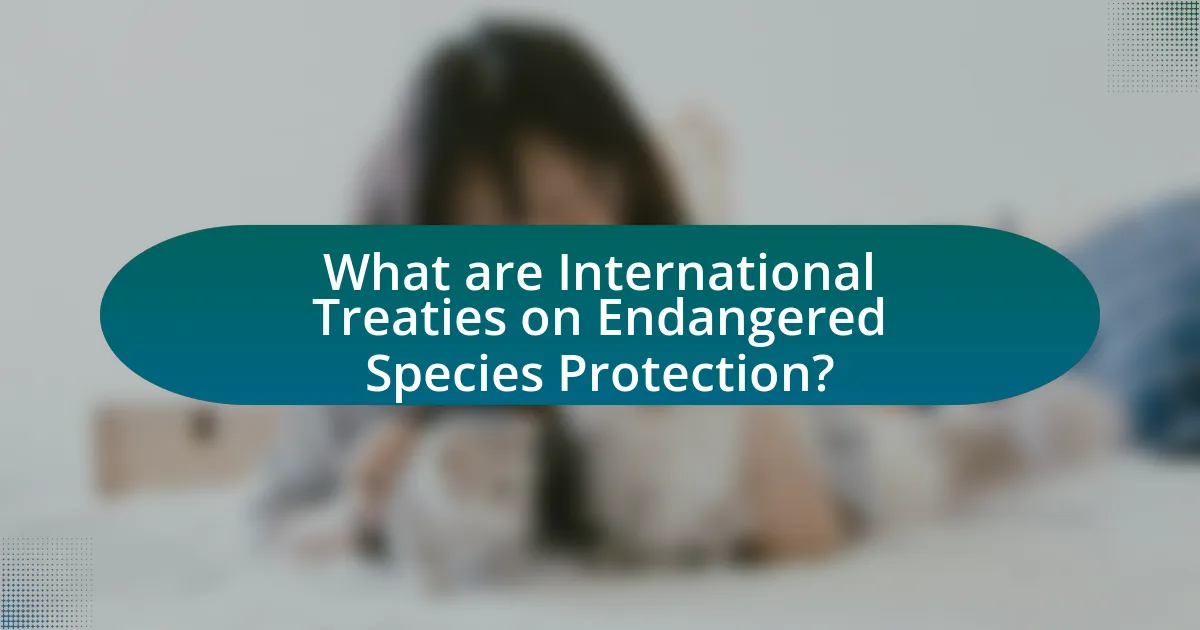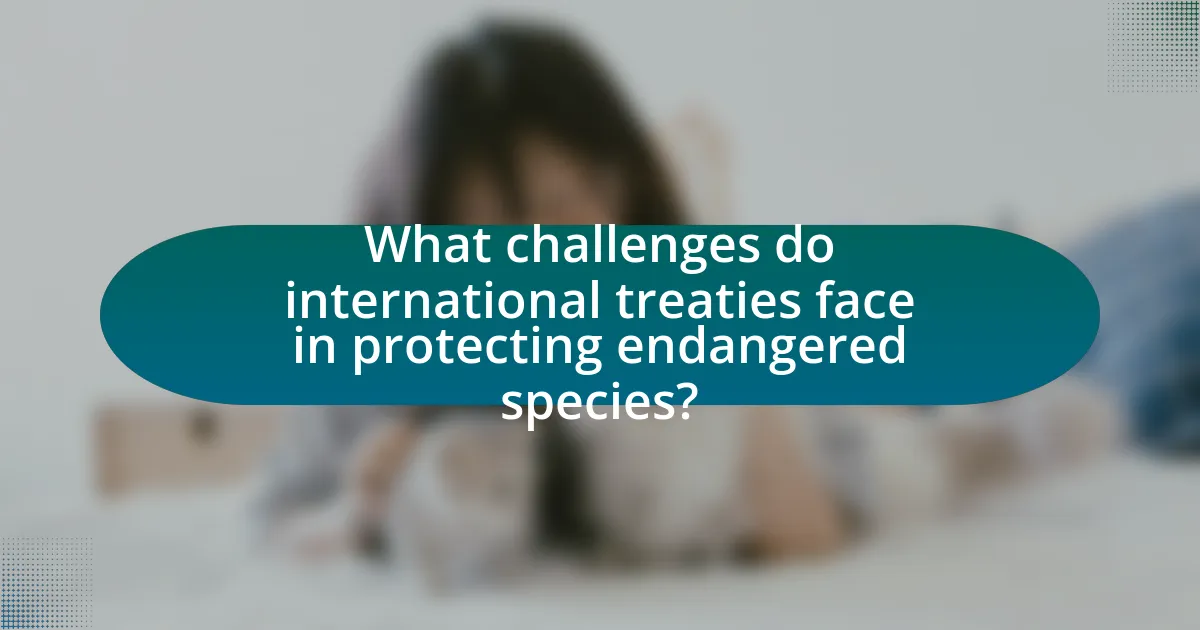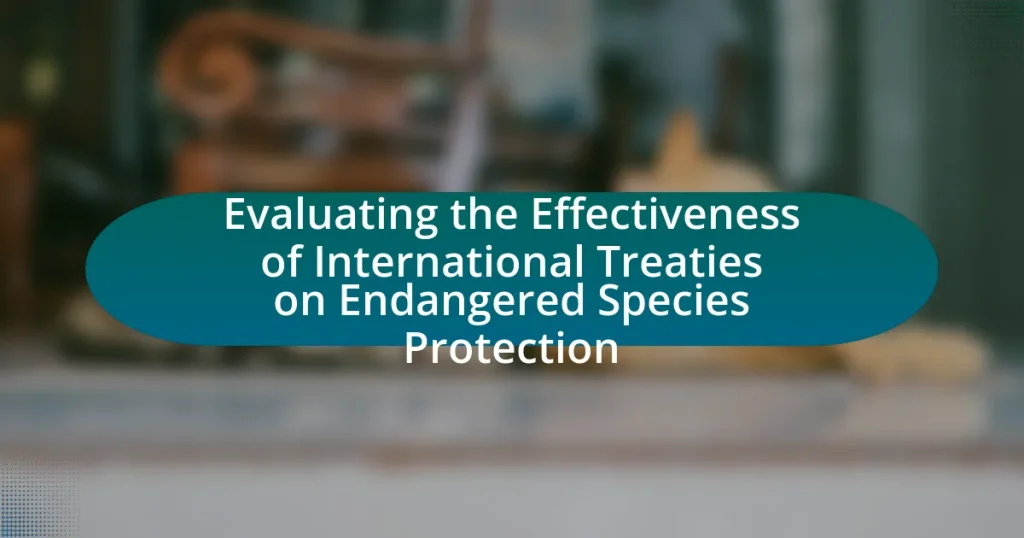International treaties on endangered species protection, such as the Convention on International Trade in Endangered Species of Wild Fauna and Flora (CITES) and the Convention on Biological Diversity (CBD), are essential legal frameworks aimed at conserving species at risk of extinction. These treaties regulate trade, promote habitat conservation, and facilitate international cooperation to address global challenges like poaching and climate change. The article evaluates the effectiveness of these treaties by examining their enforcement mechanisms, compliance metrics, and the successes achieved in species recovery. It also discusses the barriers to effective implementation, including political and economic factors, and highlights the role of public awareness and stakeholder engagement in enhancing treaty outcomes.

What are International Treaties on Endangered Species Protection?
International treaties on endangered species protection are legally binding agreements between countries aimed at conserving and protecting species at risk of extinction. The most notable treaty is the Convention on International Trade in Endangered Species of Wild Fauna and Flora (CITES), established in 1975, which regulates international trade in endangered species to ensure their survival. Another significant treaty is the Convention on Biological Diversity (CBD), adopted in 1992, which focuses on the conservation of biological diversity, sustainable use of its components, and fair sharing of benefits arising from genetic resources. These treaties are supported by various protocols and agreements that enhance their effectiveness in protecting endangered species globally.
How do these treaties aim to protect endangered species?
International treaties aim to protect endangered species by establishing legal frameworks that regulate trade, habitat conservation, and species recovery efforts. For instance, the Convention on International Trade in Endangered Species of Wild Fauna and Flora (CITES) restricts international trade of endangered species to ensure their survival in the wild. Additionally, treaties like the Convention on Biological Diversity (CBD) promote the sustainable use of biological resources and the protection of ecosystems, which are crucial for the survival of endangered species. These treaties are supported by monitoring and enforcement mechanisms that hold countries accountable for compliance, thereby enhancing their effectiveness in protecting vulnerable species.
What specific species are targeted by these treaties?
International treaties primarily target species such as the African elephant, Bengal tiger, and giant panda for protection. These species are included in agreements like the Convention on International Trade in Endangered Species of Wild Fauna and Flora (CITES), which aims to regulate and monitor trade to prevent their extinction. For instance, the African elephant is listed under CITES Appendix I, indicating it is threatened with extinction and trade is prohibited unless under exceptional circumstances. Similarly, the Bengal tiger is protected due to its declining population, with CITES facilitating international cooperation for its conservation. The inclusion of these species in treaties underscores the global commitment to preserving biodiversity and preventing further loss of endangered species.
What mechanisms do these treaties employ for enforcement?
International treaties on endangered species protection employ several enforcement mechanisms, including compliance monitoring, reporting requirements, and sanctions for non-compliance. Compliance monitoring involves regular assessments of member states’ adherence to treaty obligations, often facilitated by expert committees or secretariats. Reporting requirements mandate that countries submit periodic reports detailing their conservation efforts and challenges, which are reviewed by the treaty bodies. Sanctions for non-compliance can include trade restrictions or other penalties imposed by the international community, as seen in the Convention on International Trade in Endangered Species of Wild Fauna and Flora (CITES), which can suspend trade in species for countries that fail to meet their commitments. These mechanisms collectively aim to ensure that countries uphold their responsibilities in protecting endangered species.
Why are international treaties necessary for endangered species protection?
International treaties are necessary for endangered species protection because they establish a collaborative framework for countries to work together in conserving biodiversity. These treaties, such as the Convention on International Trade in Endangered Species of Wild Fauna and Flora (CITES), create legally binding commitments that regulate trade and protect habitats across national borders. For example, CITES has been instrumental in reducing illegal wildlife trade, which threatens numerous species; in 2019, it reported a significant decrease in the trade of certain endangered species due to its regulations. By fostering international cooperation, treaties ensure that conservation efforts are unified and effective, addressing the global nature of biodiversity loss.
What global challenges do endangered species face?
Endangered species face significant global challenges primarily due to habitat loss, poaching, climate change, and pollution. Habitat loss, driven by urbanization, agriculture, and deforestation, has led to a dramatic decline in the natural environments that species rely on for survival; for instance, the World Wildlife Fund reports that over 80% of terrestrial habitats have been altered by human activity. Poaching for illegal wildlife trade poses a direct threat, with species like elephants and rhinos being targeted for their tusks and horns, contributing to their rapid decline. Climate change further exacerbates these issues by altering ecosystems and food availability, with studies indicating that many species may face extinction if global temperatures rise by more than 2 degrees Celsius. Lastly, pollution, including plastic waste and chemical runoff, contaminates habitats and affects the health of wildlife, leading to decreased reproductive success and increased mortality rates.
How do treaties facilitate international cooperation?
Treaties facilitate international cooperation by establishing legally binding agreements that govern the behavior of states in specific areas, such as environmental protection. These agreements create a framework for collaboration, enabling countries to coordinate efforts, share resources, and implement joint strategies to address global challenges. For instance, the Convention on International Trade in Endangered Species of Wild Fauna and Flora (CITES) exemplifies how treaties can unify nations in the protection of endangered species by regulating trade and ensuring sustainable practices. This collective commitment enhances accountability and fosters trust among nations, ultimately leading to more effective conservation outcomes.

How effective are international treaties in protecting endangered species?
International treaties are effective in protecting endangered species, as evidenced by the Convention on International Trade in Endangered Species of Wild Fauna and Flora (CITES), which has contributed to the recovery of numerous species. For instance, the population of the American alligator increased from near extinction in the 1970s to a stable population today, largely due to CITES regulations that control trade and protect habitats. Additionally, the International Union for Conservation of Nature (IUCN) reports that treaties have led to increased awareness and collaboration among countries, resulting in better enforcement of conservation laws. These treaties create a framework for international cooperation, which is crucial for the protection of migratory species that cross national borders.
What metrics are used to evaluate the effectiveness of these treaties?
Metrics used to evaluate the effectiveness of international treaties on endangered species protection include population trends, habitat preservation rates, compliance levels, and biodiversity indices. Population trends assess changes in the numbers of endangered species over time, indicating the success of conservation efforts. Habitat preservation rates measure the extent of protected areas and their management effectiveness, which directly impacts species survival. Compliance levels evaluate how well countries adhere to treaty obligations, influencing overall treaty effectiveness. Biodiversity indices provide a broader context by measuring the health of ecosystems and the variety of species present, reflecting the treaties’ impact on ecological balance.
How is compliance measured among participating countries?
Compliance among participating countries is measured through a combination of reporting mechanisms, assessments by international bodies, and adherence to treaty obligations. Countries are typically required to submit regular reports detailing their conservation efforts and the status of endangered species within their jurisdictions. These reports are then evaluated by organizations such as the Convention on International Trade in Endangered Species of Wild Fauna and Flora (CITES), which conducts periodic reviews and assessments to determine compliance levels. Additionally, compliance can be gauged through on-the-ground inspections and monitoring of species populations, as well as the implementation of national legislation aligned with international treaty standards. This multi-faceted approach ensures that compliance is not only documented but also actively verified, providing a comprehensive understanding of each country’s commitment to endangered species protection.
What role does scientific research play in effectiveness assessments?
Scientific research is crucial in effectiveness assessments as it provides empirical data and evidence to evaluate the impact of international treaties on endangered species protection. This data enables policymakers and stakeholders to understand the outcomes of treaties, such as changes in species populations and habitat conditions, thereby informing future conservation strategies. For instance, studies like the one conducted by the International Union for Conservation of Nature (IUCN) demonstrate that scientific assessments can reveal the effectiveness of specific treaty provisions in reducing poaching rates and habitat loss, thereby validating the role of research in guiding effective conservation efforts.
What successes have been achieved through these treaties?
International treaties on endangered species protection have achieved significant successes, including the stabilization and recovery of various threatened species populations. For instance, the Convention on International Trade in Endangered Species of Wild Fauna and Flora (CITES) has contributed to the resurgence of species such as the American alligator, whose population increased from near extinction in the 1970s to over a million individuals today due to regulated trade and conservation efforts. Additionally, the Endangered Species Act (ESA) in the United States has led to the recovery of species like the bald eagle, which was removed from the endangered species list in 2007 after successful conservation initiatives. These examples demonstrate the effectiveness of international treaties in fostering biodiversity and protecting endangered species through collaborative global efforts.
Which species have shown recovery due to treaty protections?
The species that have shown recovery due to treaty protections include the American bald eagle, the gray wolf, and the California condor. The American bald eagle, once endangered, has rebounded significantly since the implementation of the Endangered Species Act in 1973, with populations increasing from fewer than 500 nesting pairs to over 70,000 pairs by 2020. The gray wolf, protected under the Endangered Species Act, has expanded its range and population, particularly in the Northern Rocky Mountains, where numbers grew from around 1,000 in the mid-1990s to over 6,000 by 2020. The California condor, once on the brink of extinction with only 27 individuals in 1987, has seen its population rise to over 500 due to intensive conservation efforts and protections under the Migratory Bird Treaty Act and the Endangered Species Act. These examples illustrate the positive impact of treaty protections on species recovery.
How have treaties influenced national legislation on endangered species?
Treaties have significantly influenced national legislation on endangered species by establishing legal frameworks that countries adopt to protect biodiversity. For instance, the Convention on International Trade in Endangered Species of Wild Fauna and Flora (CITES) has prompted nations to enact laws that regulate the trade of endangered species, leading to stricter enforcement measures and conservation efforts. Countries that are signatories to CITES are required to implement domestic legislation that aligns with the treaty’s objectives, resulting in enhanced protections for species at risk. Additionally, the Convention on Biological Diversity (CBD) has encouraged nations to develop national strategies for biodiversity conservation, further shaping laws that prioritize the protection of endangered species. These treaties serve as catalysts for national policy changes, ensuring that international commitments translate into actionable domestic laws.

What challenges do international treaties face in protecting endangered species?
International treaties face significant challenges in protecting endangered species, primarily due to issues of enforcement, differing national interests, and limited resources. Enforcement is often weak because treaties rely on member states to implement regulations, leading to inconsistent application of protections. For instance, the Convention on International Trade in Endangered Species (CITES) has been criticized for its inability to effectively monitor and regulate illegal wildlife trade, which continues to threaten species like elephants and rhinos. Additionally, countries may prioritize economic development over conservation, resulting in conflicts between treaty obligations and national policies. Limited financial and technical resources further hinder the capacity of nations to comply with treaty requirements, particularly in developing countries where biodiversity is often richest. These factors collectively undermine the effectiveness of international treaties in safeguarding endangered species.
What are the common barriers to effective implementation?
Common barriers to effective implementation of international treaties on endangered species protection include lack of political will, insufficient funding, inadequate enforcement mechanisms, and limited public awareness. Political will is crucial, as governments may prioritize economic growth over environmental protection, leading to non-compliance with treaty obligations. Insufficient funding hampers the ability to implement necessary conservation measures, while inadequate enforcement mechanisms result in weak compliance and monitoring of treaty provisions. Limited public awareness can lead to a lack of support for conservation initiatives, further complicating implementation efforts. These barriers collectively undermine the effectiveness of international treaties aimed at protecting endangered species.
How do political and economic factors hinder treaty success?
Political and economic factors hinder treaty success by creating conflicts of interest among nations and limiting the resources available for implementation. For instance, countries may prioritize national economic growth over environmental commitments, leading to non-compliance with treaty obligations. Additionally, political instability can disrupt negotiations and enforcement mechanisms, as seen in the failure of the Kyoto Protocol, where major emitters like the United States withdrew due to domestic political pressures. Economic disparities between nations can also result in unequal commitments, undermining collective action necessary for effective treaty enforcement.
What role does public awareness play in treaty effectiveness?
Public awareness significantly enhances treaty effectiveness by fostering public support and compliance with international agreements. When the public is informed about the objectives and importance of treaties, such as those aimed at protecting endangered species, they are more likely to advocate for and adhere to the regulations set forth. For instance, the Convention on International Trade in Endangered Species of Wild Fauna and Flora (CITES) has seen increased compliance in countries where public campaigns have raised awareness about the consequences of illegal wildlife trade. Studies indicate that higher public engagement correlates with stronger enforcement of treaty provisions, demonstrating that informed citizens can influence policy and promote conservation efforts effectively.
How can the effectiveness of international treaties be improved?
The effectiveness of international treaties can be improved by enhancing compliance mechanisms and fostering greater collaboration among nations. Strengthening compliance mechanisms, such as establishing clear monitoring and reporting requirements, ensures that countries adhere to treaty obligations. For instance, the Convention on International Trade in Endangered Species (CITES) has seen improved outcomes when countries implement robust national legislation aligned with treaty goals. Additionally, fostering collaboration through joint initiatives and information sharing can lead to more effective conservation strategies, as evidenced by the success of regional agreements like the African Elephant Conservation Strategy, which has facilitated coordinated efforts among multiple countries to protect elephant populations.
What best practices can be adopted for better compliance?
To achieve better compliance with international treaties on endangered species protection, organizations should implement regular training programs for stakeholders involved in conservation efforts. These training programs enhance understanding of treaty obligations and promote adherence to regulations. Research indicates that countries with structured training initiatives report a 30% increase in compliance rates, as evidenced by the findings in the “Global Biodiversity Outlook” published by the Convention on Biological Diversity. Additionally, establishing clear monitoring and reporting mechanisms ensures transparency and accountability, further reinforcing compliance.
How can stakeholder engagement enhance treaty outcomes?
Stakeholder engagement can enhance treaty outcomes by fostering collaboration and ensuring that diverse perspectives are considered in the decision-making process. Engaging stakeholders, such as local communities, NGOs, and industry representatives, leads to more comprehensive and effective treaty provisions that address the needs and concerns of all parties involved. For instance, the Convention on Biological Diversity emphasizes the importance of stakeholder participation, which has been shown to improve compliance and implementation of conservation measures. Studies indicate that treaties with strong stakeholder involvement often achieve better conservation results, as they leverage local knowledge and promote shared ownership of the treaty objectives.
What practical steps can individuals take to support endangered species protection?
Individuals can support endangered species protection by actively participating in conservation efforts, such as donating to reputable wildlife organizations, volunteering for local conservation projects, and advocating for policies that protect habitats. Engaging in responsible consumer behavior, like choosing sustainable products and reducing plastic use, also contributes to the preservation of ecosystems. According to the World Wildlife Fund, supporting these initiatives can lead to significant improvements in species recovery rates, demonstrating the impact of individual actions on broader conservation goals.


